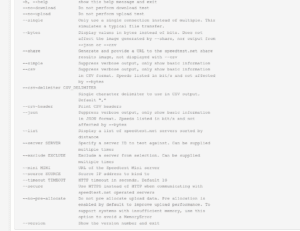
This tutorial showed how to run a speed test on pfSense. Conclusion – How to Run a Speed Test on pfSense version Show the version number and exit 3. Support systems with insufficient memory, use this Pre allocation isĮnabled by default to improve upload performance. no-pre-allocate Do not pre allocate upload data. secure Use HTTPS instead of HTTP when communicating with timeout TIMEOUT HTTP timeout in seconds. source SOURCE Source IP address to bind to mini MINI URL of the Speedtest Mini server exclude EXCLUDE Exclude a server from selection. server SERVER Specify a server ID to test against. list Display a list of servers sorted by json Suppress verbose output, only show basic information Single character delimiter to use in CSV output. csv Suppress verbose output, only show basic information simple Suppress verbose output, only show basic information share Generate and provide a URL to the share Does notĪffect the image generated by -share, nor output from bytes Display values in bytes instead of bits. single Only use a single connection instead of multiple.

no-download Do not perform download test h, -help show this help message and exit Ĭommand line interface for testing internet bandwidth using. You can use the options below to customize your command: usage: speedtest-cli You can run the command below to see the help menu. You can customize this command (especially the server, if you find the automatically located server is not the one you’d like to use). When you run the command above, you’re running the default speed test. Customizing the pfSense Speed Test Client Command The results will be shown in the Shell Output section. Please keep in mind that it will take a little bit to run.

Execute the command below to run a speed test. Execute the command below to install the pfSense speed test client, ensuring that you replace the item below in red with the current version. Ensure the command you run below matches the version you see returned in this result.ģ. For this reason, your version may be different than the version I have in this screenshot. For this reason, it’s best to search for the current version by running the command above first, then installing the latest version. NOTE: The packages are periodically updated and version numbers may change.

In the Execute Shell Command section, enter the command below and select Execute.

Select Diagnostics, then Command Prompt.Ģ. Conclusion – How to Run a Speed Test on pfSenseġ.


 0 kommentar(er)
0 kommentar(er)
